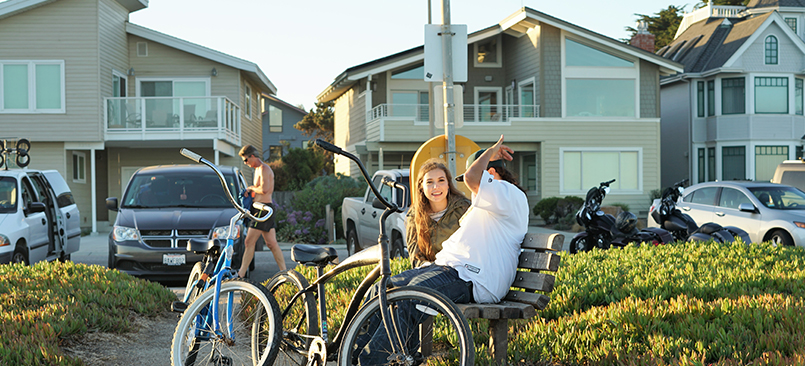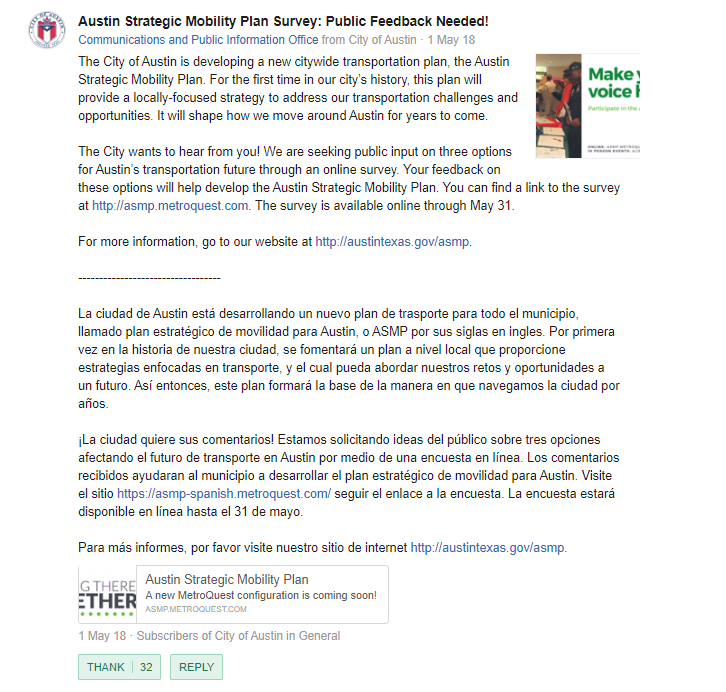6 Tips to Engage Thousands using Nextdoor to Promote Your Agency’s Survey

The City of Austin recently used MetroQuest, in partnership with national planning and design consulting firm, Kimley-Horn & Associates, to engage over 5,100 participants online! Their outstanding success is based on two factors: a great outreach plan and a fantastic MetroQuest survey that turned visitors into survey respondents. Before discussing the latter in my next post, we’ll turn our attention to one major aspect of their engagement strategy: their use of Nextdoor.
What is Nextdoor?
In a nutshell, Nextdoor is a social media platform connecting people based on their geographic locations, with the intent to “empower neighbors to build stronger, safer, and happier communities.” Using Nextdoor’s engagement tools, public service agencies including planning, utilities, police, and other local authorities can communicate with residents within their specific area or neighborhood.
Nextdoor members, meaning residents of a specific area, are automatically subscribed to receive messages from agencies that serve them, making it a simple yet effective tool to add to any agency’s engagement toolbox.
If your government agency doesn’t already have an account, you can sign up to use Nextdoor here! Nextdoor even offers a very thorough step-by-step guide on how to sign up, add users, manage the account, and view results.
How can your agency use Nextdoor for public engagement?
NextDoor’s main method of communication with your agency’s neighborhood members is via posts. There are four types of posts on Nextdoor for agencies.
- Messages: these are the most common way to communicate with residents and can be used to invite them take your online surveys. Photos (of your surveys) or documents may be added to attract attention.
- Polls: these are a quick way to ask for feedback on basic topics. Each member can vote only once. To gather more robust feedback or for more complex plans, a MetroQuest survey might be a better option. Nextdoor polls can help generate interest in your longer surveys by highlighting a single question to get people invested.
- Events: these may include notices of public meetings, workshops, or other events that complement your online engagement efforts.
- Urgent Alerts: these are exactly that – and are more applicable to public safety or emergencies.
When making a post, you can choose one of the above types, as well as indicate the target audience (more on that below). There is also an option to send a message directly to “Nextdoor Leads,” who are typically the most engaged members or the founding members of the neighborhood on Nextdoor. It’s also possible to share the message directly to other platforms including Facebook and Twitter for even greater reach and impact.
Here are 6 tips to effectively promote your public survey with Nextdoor!
What does it take to write an engaging Nextdoor post? Let’s explore six tips that can help you drive participation for your next MetroQuest survey.
- Messages include a subject line as well as body copy. Use the subject line to include an eye-catching, urgency-creating call to action. Here’s a great example: Austin Strategic Mobility Plan Survey: Public Feedback Needed!
- A major benefit of Nextdoor is the ability to choose the audience for each post – options include the entire service area/region, or a subset such as specific service areas or specific neighborhoods. Monitor the post results and use follow-up posts to target specific zip codes that received fewer initial impressions, or continue to be underrepresented in the survey.
- Similar to the MetroQuest survey itself, the post’s tone should be precise, relevant, and simple, and should avoid jargon or acronyms.
- Include a direct link to the MetroQuest survey to make it easy for people to immediately provide input, before they get distracted.
- Use an image! Pictures of happy people taking the survey on a phone or iPad can be compelling. So can an image of the survey itself.
- Create a follow-up post that includes a final call to action shortly before the survey closes. A “last chance” post always garners attention.
Nextdoor offers additional best practices, case studies, and several other resources here:
Tips are useful … but seeing them in action is even more practical. Stay tuned! In my next blog post, I’ll share how the City of Austin engaged over 5,100 residents by promoting their MetroQuest survey on Nextdoor. Here’s a teaser. Check out this powerful multi-lingual post:

Can’t wait? Liane Miller, AICP and Senior Business Process Consultant with Austin’s Transportation Department, tells all in her on-demand webinar: Online Public Engagement Playbook. Join me in congratulating Liane on her outstanding public engagement success by commenting below!